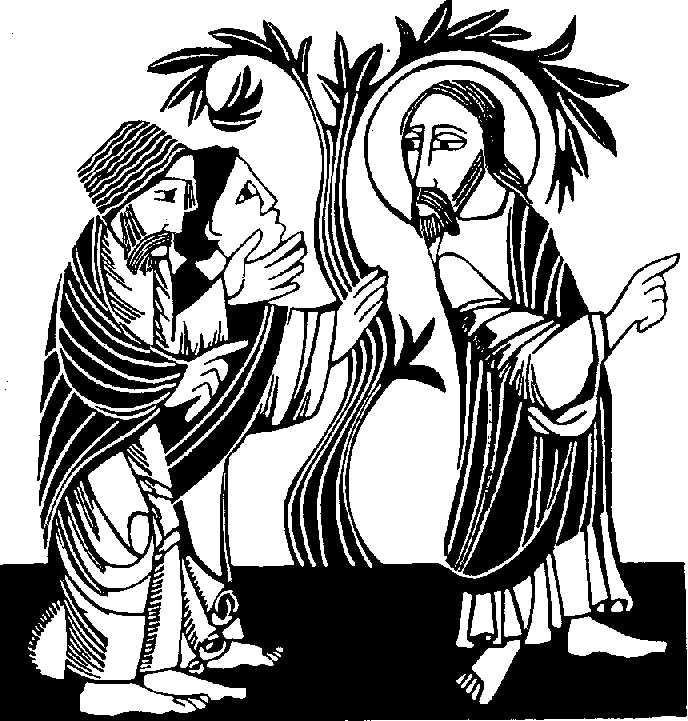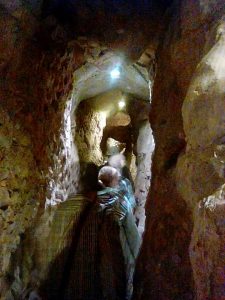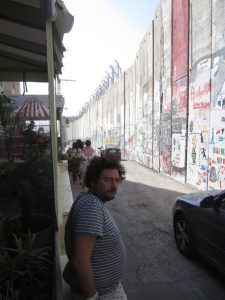
A candlelight vigil – for one of the 947 mass shootings in the last two years and 214 days?
* * * *
 Saturday August 24 is the Feast day for Bartholomew the Apostle. Unfortunately, he may best be known for the famous massacre on his feast day in 1572. There’s more on that and “St. Bart” below, but speaking of massacres (and some recent responses thereto):
Saturday August 24 is the Feast day for Bartholomew the Apostle. Unfortunately, he may best be known for the famous massacre on his feast day in 1572. There’s more on that and “St. Bart” below, but speaking of massacres (and some recent responses thereto):
I recently read on Facebook that “when Cain killed Abel, God didn’t blame the rock.” I then Googled the phrase and saw that it came from a “Top NC Republican.” See Top NC Republican on Mass Shootings: “Cain Killed Abel.” (And “God didn’t punish the rock,” to which the article writer responded, “It’s so weird how gun violence has nothing to do with guns.”)
Which sums up the response of “gun nuts,” and with it the need to clarify.
To me a Gun Nut isn’t the guy who thinks the Second Amendment is perfectly valid – including the “well-regulated” part – and goes along with the idea of responsible gun ownership. A Gun Nut is the guy who refuses to consider even the most trifling, minimal attempt to “maybe, kinda sorta” try to find some way to cut down the number mass shootings plaguing the nation.
So getting back to that “top NC Republican.” Lt. Governor Dan Forest referred to Genesis 4:8, “One day Cain suggested to his brother, ‘Let’s go out into the fields.’ And while they were in the field, Cain attacked his brother, Abel, and killed him.” Notice there’s nothing about a rock, which doesn’t speak well of Forest’s knowledge of the Bible. (See also the Titian painting below right. And for another interesting take see “Cain killed Abel with a rock”? … atheism.)
The point? Forest seemed to say that – according to the Bible – the “powers that be” in this country have no responsibility whatsoever to correct an ongoing problem resulting in frequent, unnecessary death. His take? If a man kills 40 people with an assault weapon, you hold only the man responsible. You don’t look for “cause and effect,” and you don’t even try to find out if even one person’s life could be saved by some reasonable solution.
Which is of course a gross misinterpretation of the Bible.
For one thing, Forest apparently didn’t read far enough. In Genesis 4:9 – after the murder, shown at right – God asked where Abel was. Cain answered, “I know not. Am I my brother’s keeper?” To which God said, “Your brother’s blood cries out to Me from the ground!” (Genesis 4:10, to which the Good News Translation adds, “like a voice calling for revenge.”) Which leads to this question. If God could hear the voice of one victim “crying out from the ground,” how could He possibly not hear the voices of 3,788 Americans, victims of mass shootings in the last two years, 214 days (plus)? (Conservatively-estimated, as of August 20, 2019.)
Which brings us to another Bible take, on how American society as a whole has a God-given duty to end repeat killings of which there has been ample warning. See Exodus 21:28-29:
If a bull gores a man or woman to death, the bull is to be stoned to death… But the owner of the bull will not be held responsible. If, however, the bull has had the habit of goring and the owner has been warned but has not kept it penned up and it kills a man or woman, the bull is to be stoned and its owner also is to be put to death.
So it may be true that God didn’t “blame the rock” for killing Abel.
But according to the law of Moses – Exodus 21:28-29 – the owner of a bull who keeps killing can’t avoid guilt by saying, “Don’t blame me! Blame the bull!” According to God’s Word, the owner of a rogue bull is responsible for his failure to keep the second death from happening. (Or the third, or the 3,788th.) As reasonably interpreted, that principle applies to American society as a whole, when it knows the danger of repeated, ongoing mass killing.
On that note, see Dog owner charged with murder after fatal mauling (8/22/19):
The owner of three dogs that fatally mauled 9-year-old Emma Hernandez on Monday has been charged with murder… Wayne County Prosecutor Kym Worthy announced Thursday that Pierre Cleveland, 33, will face charges of second-degree murder, involuntary manslaughter and having a dangerous animal causing death.
That third charge – having a dangerous animal causing death – goes directly back to Exodus 21:28-29. (It was noted at the hearing that members of Cleveland’s family “cried out in the courtroom when [the] prosecution alleged Cleveland knew his dogs were dangerous.”)
So did the pit bulls themselves – alone – “cause” the fatal mauling? Or was it a combination, of pit bulls being inherently dangerous and the owner’s failure to “keep the dogs in check?”
 Some further notes: The dogs were set to be euthanized (in accordance with Exodus 21:28), on which note prosecutors argued that Cleveland knew the dogs were dangerous. Yet he left them alone, “despite the dogs allegedly having killed a puppy in Cleveland’s home a week before.” Then too “one of the dogs had also killed multiple puppies on July 29.”
Some further notes: The dogs were set to be euthanized (in accordance with Exodus 21:28), on which note prosecutors argued that Cleveland knew the dogs were dangerous. Yet he left them alone, “despite the dogs allegedly having killed a puppy in Cleveland’s home a week before.” Then too “one of the dogs had also killed multiple puppies on July 29.”
So to repeat: According to Exodus 21:28-29, Americans as a group – by and through their elected representatives – can’t escape responsibility by saying “blame the rock!” Which brings us back to the Feast day for “St. Bartholomew, also known as Bartholomew the Apostle.*” As to that famous massacre see St. Bartholomew – and “his” Massacre (8/2017).
More to the point – and as to the Catholic Church’s responsibility for the massacre – here’s what Pope John Paul II said in August of 1997, in Paris, where the massacre took place:
On the eve of Aug. 24, we cannot forget the sad massacre of St. Bartholomew’s Day… Christians did things which the Gospel condemns. I am convinced that only forgiveness, offered and received, leads little by little to a fruitful dialogue… Belonging to different religious traditions must not constitute today a source of opposition and tension. On the contrary, our common love for Christ impels us to seek tirelessly the path of full unity.
So here’s hoping that some day soon we too in America may begin a “fruitful dialogue.” Like on how to stop the great number of mass shootings that presently plague our nation…
* * * *

The Louvre, August 24, 1572: Catherine de’ Medici (in black) considers “her” massacre…
* * * *
The upper image is courtesy of Mass Shooting – Image Results. The photo accompanies an article, “Stop blaming the mentally ill for mass shootings.” With a comment by conservative author Ann Coulter: “Guns don’t kill people, the mentally ill do.” The article noted less than 5 percent of the “120,000 gun-related killings in the U.S. between 2001 and 2010 were committed by people diagnosed with mental illness.” Instead, people with mental illness were more likely to be victims. “You’re more likely to be attacked by other people, more likely to be shot,” one professor said. “You’re odd. You’re a target.” Also, mass shootings are most often attributed to things like disgruntled workers or family disputes. “It’s loss of control by people who are extremely angry.” Finally the article said efforts to link mental illness and violence are “a political strategy to turn attention away from more serious efforts to restrict access to the means of violence – which is guns.”
The black-and-white image to the left of the paragraph “Saturday, August 24” – “Jesus-and-fig-tree” – is courtesy of Jesus, Philip, Nathanael and the Fig Treesacredstory.org.
The Cain and Abel image is courtesy of Wikipedia: “Cain and Abel, 16th-century painting by Titian.”
Re: The number of “recent” mass shootings. See An update on “Trump’s” mass shootings, from a companion blog, first posted on May 3, 2019, but updated August 20, 2019. As of 8/20/19 the number of mass shootings in the last “How long has Trump been president” stood at 947. The definition of mass shooting – a minimum of four victims – led to the calculation of 3,788.
The image at left of the paragraph with “set to be euthanized (in accordance with Exodus 21:28),” is courtesy of Bull Gore – Image Results. Accompanied by an article, “British student escapes death after being gored by killer bull at Pamplona festival.” Thus note that Exodus 21:28 apparently doesn’t apply to injuries resulting from one’s own stupidity. See also Running of the bulls – Wikipedia.
More about St. Bartholomew: This “St. Bart” is generally identified as the Nathanael Jesus saw – in the first chapter of the John’s Gospel – sitting under a fig tree. As to the way he died, one tradition says that during his last missionary journey he was “flayed alive and crucified, head downward.”
The lower image is courtesy of St. Bartholomew’s Day massacre – Wikipedia. The full caption: “‘One morning at the gates of the Louvre,’ 19th-century painting by Édouard Debat-Ponsan. Catherine de’ Medici is in black. The scene from Dubois [is] re-imagined.”




 For more on this James see
For more on this James see 